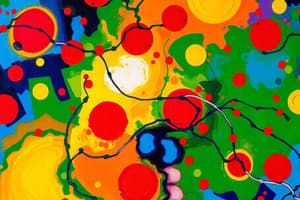Podcast
Questions and Answers
Which regulatory mechanism involves altering the location of a protein, effectively isolating it from necessary cofactors?
Which regulatory mechanism involves altering the location of a protein, effectively isolating it from necessary cofactors?
- Sequestration (correct)
- Degradation
- Modification
- Binding
A mutation alters a protein's structure, decreasing its affinity for ubiquitin ligases. What is the MOST likely consequence?
A mutation alters a protein's structure, decreasing its affinity for ubiquitin ligases. What is the MOST likely consequence?
- Decreased protein degradation.
- Increased protein degradation.
- Increased protein half-life.
- Both B and C (correct)
Which of the following best describes the relationship between protein structure and function?
Which of the following best describes the relationship between protein structure and function?
- Similar structures tend to have similar functions. (correct)
- Similar structures always have identical functions.
- Variations in structure have no effect on function.
- Protein structure is unrelated to protein function.
A researcher discovers a novel protein motif within a newly identified enzyme. Based on the information, what is the MOST likely primary role of this motif?
A researcher discovers a novel protein motif within a newly identified enzyme. Based on the information, what is the MOST likely primary role of this motif?
If a protein's expression is increased due to transcriptional regulation, how does this affect enzyme regulation, assuming the protein is an enzyme?
If a protein's expression is increased due to transcriptional regulation, how does this affect enzyme regulation, assuming the protein is an enzyme?
Which of the following is NOT a general mechanism that initiates protein degradation?
Which of the following is NOT a general mechanism that initiates protein degradation?
Ubiquitylation is a crucial step in protein degradation. What is the primary role of ubiquitin in this process?
Ubiquitylation is a crucial step in protein degradation. What is the primary role of ubiquitin in this process?
What is the MOST direct effect of proteolysis on cellular regulation?
What is the MOST direct effect of proteolysis on cellular regulation?
A cell experiences a buildup of damaged proteasomes. Which process would MOST likely be activated to remove these?
A cell experiences a buildup of damaged proteasomes. Which process would MOST likely be activated to remove these?
Which of the following mechanisms is primarily responsible for the rapid termination of a signaling cascade involving protein modification?
Which of the following mechanisms is primarily responsible for the rapid termination of a signaling cascade involving protein modification?
A researcher is studying protein degradation pathways and observes a significant accumulation of oxidatively-modified proteins within the mitochondria. Which type of proteinase is most likely malfunctioning?
A researcher is studying protein degradation pathways and observes a significant accumulation of oxidatively-modified proteins within the mitochondria. Which type of proteinase is most likely malfunctioning?
A cell experiences a sudden increase in damaged intracellular proteins. Which protein degradation pathway would be most immediately activated to remove these proteins?
A cell experiences a sudden increase in damaged intracellular proteins. Which protein degradation pathway would be most immediately activated to remove these proteins?
During protein processing, how do dietary proteins differ from endogenous proteins in terms of their initial degradation pathways?
During protein processing, how do dietary proteins differ from endogenous proteins in terms of their initial degradation pathways?
A researcher discovers a novel protein that is rapidly degraded in cells. Further analysis reveals that the protein is heavily ubiquitylated. Which degradation pathway is most likely involved in its turnover?
A researcher discovers a novel protein that is rapidly degraded in cells. Further analysis reveals that the protein is heavily ubiquitylated. Which degradation pathway is most likely involved in its turnover?
A scientist is investigating a cellular response to proteasome inhibition. What compensatory mechanism is most likely to be upregulated in response to this inhibition?
A scientist is investigating a cellular response to proteasome inhibition. What compensatory mechanism is most likely to be upregulated in response to this inhibition?
Which structural motif is characterized by the repetition of a simple loop connecting two antiparallel beta strands, often found in beta-sheet rich proteins?
Which structural motif is characterized by the repetition of a simple loop connecting two antiparallel beta strands, often found in beta-sheet rich proteins?
A protein domain is best described as which of the following?
A protein domain is best described as which of the following?
Which of the following protein domains is most likely involved in mediating protein-protein interactions within a signaling pathway?
Which of the following protein domains is most likely involved in mediating protein-protein interactions within a signaling pathway?
What impact does an N-terminal arginine residue typically have on a protein's half-life within a cell?
What impact does an N-terminal arginine residue typically have on a protein's half-life within a cell?
How do post-translational modifications regulate protein half-life?
How do post-translational modifications regulate protein half-life?
Which of the following is an example of post-translational modification that can target a protein for degradation?
Which of the following is an example of post-translational modification that can target a protein for degradation?
What is the primary purpose of protein degradation in cells?
What is the primary purpose of protein degradation in cells?
Which cellular condition is most likely to trigger protein degradation?
Which cellular condition is most likely to trigger protein degradation?
A protein damaged by reactive oxygen species (ROS) is most likely to undergo what process?
A protein damaged by reactive oxygen species (ROS) is most likely to undergo what process?
What cellular process occurs when the functional need for a specific protein has been met?
What cellular process occurs when the functional need for a specific protein has been met?
Flashcards
Protein Domain
Protein Domain
A distinct structural unit of a protein with a specific function. Think of it as a modular component.
Protein Motif
Protein Motif
A recurring combination of secondary structures (alpha helices, beta sheets) in proteins. Often mainly structural.
Protein Half-Life
Protein Half-Life
The time it takes for half of a protein to be degraded or removed. Stability.
Proteolysis
Proteolysis
Signup and view all the flashcards
Transcriptional Regulation (of Proteins)
Transcriptional Regulation (of Proteins)
Signup and view all the flashcards
Translational Regulation (of Proteins)
Translational Regulation (of Proteins)
Signup and view all the flashcards
Protein Regulation by Binding
Protein Regulation by Binding
Signup and view all the flashcards
Protein Sequestration
Protein Sequestration
Signup and view all the flashcards
Protein Modification
Protein Modification
Signup and view all the flashcards
Half-life tied to activity
Half-life tied to activity
Signup and view all the flashcards
N-terminal Residues
N-terminal Residues
Signup and view all the flashcards
Post-translational Modification
Post-translational Modification
Signup and view all the flashcards
Ubiquitylation
Ubiquitylation
Signup and view all the flashcards
Protein Degradation
Protein Degradation
Signup and view all the flashcards
Triggers for Degradation
Triggers for Degradation
Signup and view all the flashcards
Cellular Maintenance
Cellular Maintenance
Signup and view all the flashcards
Lysosome
Lysosome
Signup and view all the flashcards
Ubiquitin-Proteasome
Ubiquitin-Proteasome
Signup and view all the flashcards
Calpains
Calpains
Signup and view all the flashcards
Ubiquitin
Ubiquitin
Signup and view all the flashcards
Proteasome
Proteasome
Signup and view all the flashcards
Autophagy
Autophagy
Signup and view all the flashcards
Study Notes
Protein/Enzyme Regulation
- Most enzymes are proteins subject to regulation principles.
- Regulation occurs at the levels of expression/availability (transcriptional regulation) and translational regulation.
- Regulation can involve binding, sequestering, modifying, or degrading proteins.
- Binding can form complexes or prevent associations.
- Sequestering involves placing proteins in the wrong compartment or separating them from cofactors or coenzymes.
- Modification involves adding or removing functional groups to control activity.
- Degradation involves proteolysis or protein breakdown.
Basic Protein Concepts
- Structure relates to function.
- Similar structures often have similar functions.
- Motifs are super secondary structures that are structurally important.
- Domains represent tertiary structural portions with functional importance.
- Protein half-life is tied to activity and cellular needs.
- Continuous synthesis and degradation balance cellular content.
Protein Half-Life
- Proteins exhibit variable half-lives linked to their cellular functions.
- N-terminal residues can promote rapid protein turnover.
- N-terminal arginine correlates to a shorter half-life.
- N-terminal methionine correlates to a longer half-life.
- Half-life is controlled via post-translational modification.
- Modifications can stabilize or target proteins for degradation, such as ubiquitylation.
Protein Degradation
- Protein degradation is a mechanism for cellular maintenance that manages protein availability.
- Damaged proteins are degraded.
- General degradation triggers include environmental stress, inappropriate modification/damage (ROS damage), and when a functional need has been met (e.g., rapid signaling molecule removal).
- Mechanisms include modification to target and proteolytic cleavage of proteins into amino acid components.
Proteolysis
- Proteolysis degrades proteins, and consists of specialized mechanisms that operate in cell compartments.
- Proteolysis mechanisms include lysosomes, ubiquitin-proteasome activity, calpains, mitochondrial proteinases, and membrane proteinases.
- Lysosomes break down intracellular proteins and those entering via endocytosis.
- Ubiquitin-proteasomes clear most intracellular proteins and remove damaged ones.
- Calpains degrade cytoskeletal proteins.
- Mitochondrial proteinases act on oxidatively modified mitochondrial proteins.
- Membrane proteinases degrade membrane-associated, secretory, endocytosed, and newly synthesized but faulty proteins.
Processing Proteins
- Dietary proteins are processed through digestive organs.
- Endogenous proteins may have short lives or transient roles, or be misfolded.
- Endogenous proteins are usually ubiquitinated for proteasome processing.
Ubiquitin/Ubiquitylation
- Ubiquitin is a highly conserved small protein with 76 amino acids.
- It covalently binds to the ε-amino group of lysine residues.
- A 3-enzyme complex adds ubiquitin.
- Ubiquitin enzymes are an activating enzyme (E1), a conjugating enzyme (E2), and a ligase (E3).
- Ubiquitin can create long chains/tails in tandem, or alone at multiple sites.
Autophagy/Ubiquitin
- Autophagy and ubiquitin can function independently or dependently for cellular waste management.
- It can also function in tandem with the proteasome.
Proteolysis via Proteasome
- The proteasome is a barrel-shaped complex with a core particle and regulatory particle(s).
- Degradation requires recognition of the molecule to be destroyed with ubiquitylation.
- Targeted proteins go to the proteasome by ubiquitin recognition or shuttle proteins.
- Deubiquitinating enzyme removes ubiquitin so the rest of the protein undergoes denaturing and shunting.
Proteasome Proteolysis
- Proteasome recycling or destruction is occasionally necessary.
- It can be triggered by inhibition or cellular starvation, with reliance on Autophagy.
- Autophagy acts to replace altered or inhibited proteolysis.
Protein Degradation to Evaluate Protein Composition
- The Edman Degradation Method removes one amino acid to sequence acids in proteins.
- Phenyl isothiocyanate (PITC) converts the N-terminal amino acid to a phenyl thiocarbamoyl derivative in alkaline solution.
- Acid hydrolysis removes the amino acid as a PTH derivative.
- Amino acid is identified by HPLC; using chromatographic evaluation (charge, size, and/or hydrophobicity).
Implications of Altered Proteolysis
- Protein targeting and degradation play a key role in homeostasis; targeting and degradation processes must to remain intact.
Studying That Suits You
Use AI to generate personalized quizzes and flashcards to suit your learning preferences.




